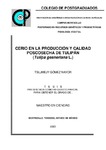| dc.description.abstract | El objetivo de esta investigación fue evaluar el efecto de diferentes concentraciones Ce adicionadas tanto en la solución nutritiva como vía foliar, en parámetros de crecimiento y desarrollo, calidad poscosecha, estatus nutrimental y contenido de algunas biomoléculas, en el cultivo de tulipán cv. Jan van Nes. Para lo anterior, se realizaron cuatro experimentos, en todos se emplearon cuatro niveles de Ce (0, 5, 15 y 15 µM). En un primer experimento, el Ce se suministró junto con la solución nutritiva desde el primer día de la siembra de los bulbos, los resultados muestran que, una baja concentración de Ce (5 µM) estimulan la brotación y la floración temprana y mejora los parámetros de crecimiento y desarrollo. En contraste, altas dosis de Ce causan efectos negativos, pero aumentan el contenido de azúcares solubles totales, prolina y clorofila. En un segundo experimento se realizaron dos aplicaciones foliares de Ce con intervalos de 15 días. Se encontró que bajas concentraciones de Ce (5 y 15 µM) muestran efectos negativos o nulos en los parámetros de crecimiento y desarrollo a los 40 días después de la plantación. Sin embargo, después de este periodo, algunos de los parámetros mejoraron con las concentraciones 15 y 25 µM Ce. En el tercer experimento, se evaluó el efecto del Ce aplicado en la solución nutritiva durante el ciclo productivo en la calidad poscosecha y vida de florero. Se observó que 5 y 25 µM Ce mejoran los parámetros de calidad poscosecha, contenido nutrimental y de algunas biomoléculas, pero no prolongó la vida de florero. En el último experimento, se estudió el efecto del Ce suministrado vía foliar durante el ciclo productivo en la calidad poscosecha y vida de florero. Se encontró que el Ce a concentraciones de 5 a 25 µM afecta de manera diferencial los parámetros de calidad, contenido nutrimental y de algunas biomoléculas, sin presentar mejoras en la vida de florero de tulipán. Se concluye que el Ce puede tener efectos horméticos (modelo bifásico dosis-respuesta). Dentro de las perspectivas se recomienda realizar estudios en los que se evalúen mayores rangos de concentraciones, así como, modos, intervalos y tiempos de aplicación de este elemento. De importancia también es la elucidación de los procesos de absorción y acumulación de Ce suministrado a raíz y al follaje. Para esta última forma de suministro de Ce, se sugieren también realizar estudios relacionados con la morfología foliar, incluyendo análisis de potenciales alteración en estomas, y estructura interna de la hoja, entre otros. _______________ CERIUM IN TULIP POST-HARVEST PRODUCTION AND QUALITY (Tulipa gesneriana L.). ABSTRACT: The objective of this research was to evaluate the effect of different Ce concentrations added both in nutritive solution and in foliar applications, on growth and development parameters, post-harvest quality, nutritional status, and content of some biomolecules in the tulips cv. Jan van Nes. Therefore, four experiments were carried out, in all of them four Ce levels were used (0, 5, 15 and 15 µM). In the first experiment, Ce was supplied together with the nutrient solution since the first day of planting the bulbs, the results show that a low concentration of Ce (5 µM) stimulates early sprouting and flowering and improves growth and development parameters. In contrast, high doses of Ce cause negative effects, but increase the content of total soluble sugars, proline and chlorophyll. In a second experiment, two foliar applications of Ce were sprayed at intervals of 15 days. Low Ce concentrations (5 and 15 µM) were found to show negative or no effects on growth and development parameters at 40 days after planting. However, after this period, some of the parameters improved with the concentrations of 15 and 25 µM Ce. In the third experiment, the effect of the Ce applied via nutrient solution during the production cycle on postharvest quality and vase life was evaluated. It was observed that 5 and 25 µM Ce improve postharvest quality parameters, nutritional content, and some biomolecules, but did not prolong the vase life. In the last experiment, the effect of the Ce supplied via foliar spray during the productive cycle on postharvest quality and vase life was studied. It was found that Ce concentrations from 5 to 25 µM differentially affect the quality parameters, nutritional content and of some biomolecules, without showing improvements in the vase life of the tulip. It is concluded that Ce can have hormetic effects (biphasic dose-response model). Within the perspectives, it is recommended to carry out studies in which greater ranges of concentrations are evaluated, as well as modes, intervals, and times of application of this element. It is also of importance the elucidation of the processes of absorption and accumulation of Ce supplied to the root and the foliage. For this last form of Ce supply, it is also suggested to carry out studies related to leaf morphology, including analysis of potential alteration in stomata, and internal structure of the leaf, among others. | es_MX |


